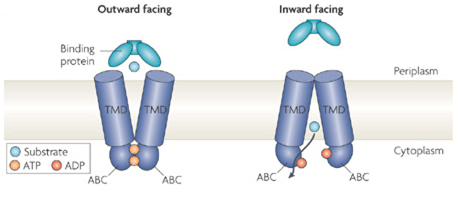Custom MemPro™ Services for ATP-binding Cassette Transporters
Creative Biostructure provides custom gene-to-structure services for ABC transporters.
ATP-binding cassette (ABC) transporter superfamily is the largest transporter family which is involved in maintaining lipid bilayer and transporting specific molecules across lipid membrane. Their ubiquitous distribution reflects the fundamental requirement of cellular homeostasis and they are believed to express in all cells of all species including plants, fungi, yeast and animals. In human, ABC transporters predominantly expressed in the liver, blood-brain-barrier (BBB), kidney and intestine. ABC transporters transport various molecules including sugars, amino acids, metal ions, peptides and proteins across plasma membrane as well as intracellular membrane. They typically contain two sets of transmembrane domains (TMDs) and a pair of ATP-binding domains, also known as nucleotide binding folds (NBF). The highly conversed NBF domains transform chemical potential of ATP into protein conformation changes while TMDs are much variable to suit different cargos.

Figure 1. Typical model of ABC transporter
The human genome contains 49 ABC genes, and ABC transporter superfamily could be further divided into 7 subfamilies according to phylogenetic analysis. ABC transporters also participate in the movement of most drugs and their metabolites across cellular organelle membranes and plasma membrane; thus, defects in these genes have potential effects in terms of cancer therapy, pharmacokinetics and innumerable pharmacogenetic disorders. X-ALD, which is an X-linked recessive disorder caused by mutant of ABCD1 gene, is characterized by neurodegenerative phenotypes with onset typically in late childhood. More than four hundred mutations have been documented to be related with X-ALD. ALD patients have an abnormal accumulation of unbranched saturated fatty acids. Current treatment consisting of erucic acid, a C22 monounsaturated fat, and oleic acid, a C18 monounsaturated fat (Lorenzo's oil), was developed that results in a normalization of the very long chain fatty acids (VLCFA) levels in the blood of patients but does not appear to dramatically slow the progression of the disease. ABCD1 is one of four related peroxisomal transporters that are found in the human genome, the others being ABCD2, ABCD3, and ABCD4. These genes are highly conserved in evolution. They also provides a potential therapeutic strategy to treat X-ALD.
ABC transporters are up-regulated to decrease uptake of some compounds when cell exposed to toxic experiment and develop resistance. Cells that overexpress ABC transporters display multidrug resistance (MDR) and tend to transport a wide variety of hydrophobic compounds including anticancer agents. Three ABC gene appear to be responsible for nearly all the MDR tumor cells in human. They are ABCB1, ABCC1 and ABCG2, since they are frequently observed to overexpress on the tumor cell surface. It is essential to elucidate the structure and mechanism of ABC transporters for rational drug design and regulate their function.
References:
Dean M, Hamon Y, Chimini G. The human ATP-binding cassette (ABC) transporter superfamily[J]. Journal of lipid research, 2001, 42(7): 1007-1017.>
Vasiliou V, Vasiliou K, Nebert D W. Human ATP-binding cassette (ABC) transporter family[J]. Human genomics, 2009, 3(3): 1.